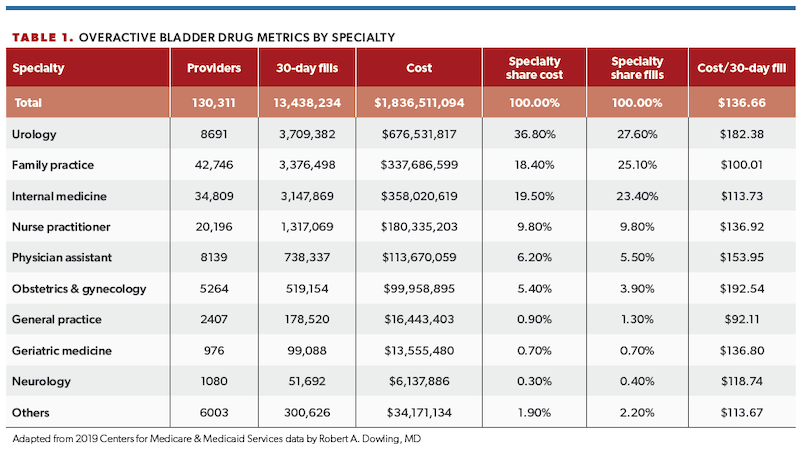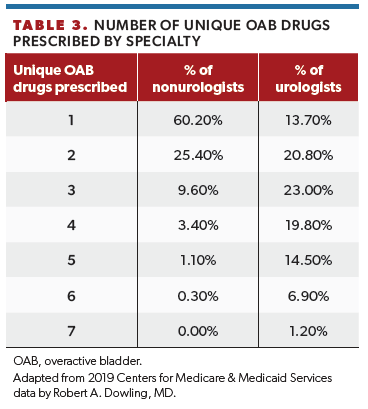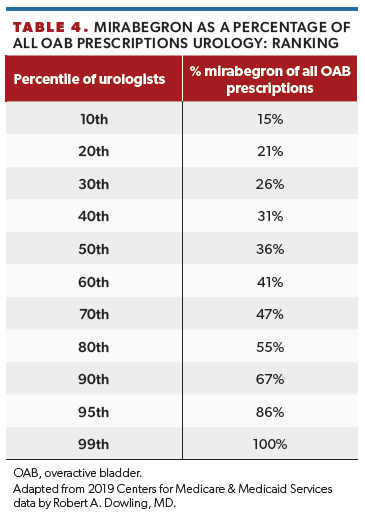Article
Understanding your prescribing habits: OAB drugs
Author(s):
Urologists tend to prescribe more expensive drugs than nonurologists.
Robert A. Dowling, MD

Overactive bladder (OAB) is a chronic condition that may affect up to 43% of women and a quarter of men in the US. These patients comprise a significant fraction of the typical urology practice and are candidates for several different treatments. Clinical guidelines call for the use of behavioral therapies as a first-line treatment and pharmaceutical agents as second-line therapy. In practice, then, almost all urologists prescribe medications for OAB.
Patient adherence and persistence with the medical management of OAB is a known problem that is generally attributed to lack of effectiveness, unmet expectations, or adverse effects.1 The association between pharmaceutical industry payments and OAB drug prescribing is less well understood.2 The Centers for Medicare & Medicaid Services recently updated their information on prescription claims for Medicare beneficiaries enrolled in Part D (prescription drug coverage) to include 2019 data on providers and drugs.3 Approximately two-thirds of Medicare beneficiaries are enrolled in Part D drug plans, and this data set is a good representation of the prescribing habits of all Medicare providers. In this article, I will review how the data reveal patterns in utilization and cost of the drugs for OAB in the Medicare population, as well as how you might interpret that information for your own use.

Drugs used to treat OAB constitute a significant number of prescriptions for the elderly. More than 13 million prescriptions of 8 generic (17 brand) drugs cost the Medicare Part D program over $1.8 billion in 2019 (approximately 1.3% of total Part D cost). Urologists prescribed more OAB drugs to Medicare beneficiaries in 2019 than any other single specialty (28%)—although, collectively, primary care physicians prescribed the most (Table 1). Urologists prescribed more expensive drugs than any other specialists and were responsible via prescribing for 37% of the total cost of OAB drugs in 2019.

Two generic drug formulations comprised more than 80% of all OAB Medicare Part D drug prescriptions in 2019: oxybutynin chloride (58%) and mirabegron (Myrbetriq; 25%). Urologists were 1.5 times more likely to prescribe mirabegron to their Medicare patients than nonurologists. It may surprise some to learn that the total retail cost of a 30-day prescription for mirabegron ($384) is 15 times more expensive than oxybutynin chloride ($25; Table 2). Although plan benefits are somewhat complicated and change frequently from year to year, beneficiaries typically pay approximately 25% of the drug cost during the initial coverage phase. Notwithstanding that these are 2 very different drugs with different benefit and safety profiles, the patient may see 2 drugs for the same problem but very different impacts on their wallet. Indeed, this may contribute to persistence and adherence. The cost/30-day prescription for all OAB generic drugs is listed in Table 2.

Another metric of interest is the number of unique OAB drugs prescribed by providers. Most (60%) nonurology providers prescribed only 1 OAB drug in 2019; most urology providers prescribed 3 or more drugs (Table 3). This pattern is consistent with the urologist’s role as the OAB expert and the common urologic practice of trying more than 1 medication for the OAB patient.

How do your OAB prescribing habits compare with your peers? To view your data, go to https://bit.ly/3qO8wFE, select “view data,” and search for your NPI number or name. Your 2019 data can easily be exported to a spreadsheet and viewed. Filter on OAB drug names to construct your own data, determine what percentage of each drug you prescribe, and compare it with Table 2. Table 4 allows you to specifically benchmark your relative use of mirabegron. For example, if mirabegron constitutes 50% of your OAB prescriptions, your relative prescribing of this drug is higher than 75% of your urology peers. Keep in mind that although Medicare beneficiaries typically comprise a significant fraction of a urology practice, your prescribing habits reflected here may not be generalizable to all patients, especially commercial or Medicare Advantage plans with formulary considerations and/or step therapy requirements.
The bottom line and why it matters
The 2019 Medicare data suggest urologists prescribe OAB drugs to Part D beneficiaries in higher quantities than most other specialists and tend to use more types of drugs and more expensive drugs (mirabegron) than nonurology specialties. As OAB experts, adherents of clinical guidelines, stewards of responsible prescribing, and potential recipients of industry payments, urologists should be aware of how their prescribing habits compare with urology peers and benchmarks, as well as how they contribute to out-of-pocket costs for their patients.
References
1. Kim TH, Lee KS. Persistence and compliance with medication management in the treatment of overactive bladder. Investig Clin Urol. 2016;57(2):84-93. doi:10.4111/icu.2016.57.2.84
2. Modi P, Ingham M, Singer E, Chang S. Pharmaceutical industry payments and physician prescribing of urologic drugs. J Urol.2017;197(4S):e929. doi:10.1016/j.juro.2017.02.2304
3. Medicare Part D prescribers - by provider and drug. Centers for Medicare & Medicaid Services. August 31, 2021. Accessed May 16, 2022. https://bit.ly/3qO8wFE

















